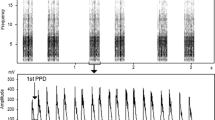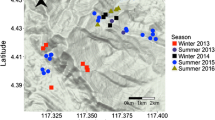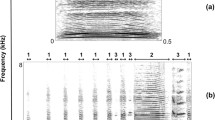Abstract
Researchers have documented individual vocal recognition in several primate species but do not know whether the changes in acoustical parameters that might occur over distance influence the informational content of a call that relates to individuality. Accordingly, we performed playback experiments using male orangutan long-distance calls (long calls) and rerecorded them at increasing distances from the source. We aimed to determine 1) which acoustical parameters changed over distance and 2) whether the percentage of calls that a discriminant analyses would assign to the correct individual would change over distance. High-frequency harmonics were attenuated and lost with increasing distance, but other parameters did not change. The percentage of calls assigned to the correct individual did not change over distance, indicating that even though there are some acoustical changes over distance the opportunity for other individuals to recognize the caller remains similar until ≤300 m, which was the maximum distance at which we rerecorded calls. Extending similar experiments to other primate species and other taxa, while subsequently conducting experiments to assess whether individual discrimination by receivers is indeed based on relatively stable acoustical parameters, would forward our understanding of acoustic communication.
Access this article
We’re sorry, something doesn't seem to be working properly.
Please try refreshing the page. If that doesn't work, please contact support so we can address the problem.




Similar content being viewed by others
References
Brown, C. H. (2003). Ecological and physiological constraints for primate vocal communication. In A. A. Ghazanfar (Ed.), Primate audition: Ethology and neurobiology (pp. 127–149). Boca Raton, FL: CRC Press.
Cheney, D. L., & Seyfarth, R. M. (1980). Vocal recognition in free-ranging vervet monkeys. Animal Behaviour, 28, 362–367.
Cheney, D. L., & Seyfarth, R. M. (1999). Recognition of other individuals’ social relationships by female baboons. Animal Behaviour, 58, 67–75.
Davila Ross, M. (2003). The long-calls of wild male orangutans: A phylogenetic approach. PhD thesis, Tierarzliche Hochschule Hannover, Hannover.
Davila Ross, M., & Geissmann, T. (2007). Call diversity of wild male orangutans: A phylogenetic approach. American Journal of Primatology, 69, 305–324.
Delgado, R. A. (2003). The function of adult male long-calls in wild orangutans (Pongo Pygmeus). PhD thesis, Duke University, Durham, NC.
Delgado, R. A. (2007). Geographic variation in the long calls of male orangutans (Pongo spp.). Ethology, 113, 487–498.
Delgado, R. A., & van Schaik, C. P. (2000). The behavioral ecology and conservation of the orangutan (Pongo pygmaeus): A tale of two islands. Evolutionary Anthropology, 9, 201–218.
Dominy, J., Lucas, P., Osorio, D., & Yamashita, N. (2001). The sensory ecology of primate food perception. Evolutionary Anthropology, 10, 171–186.
Fischer, J. (2004). Emergence of individual recognition in young macaques. Animal Behaviour, 67, 655–661.
Galdikas, B. M. F. (1983). The orangutan long-call and snag crashing at Tanjung Puting Reserve. Primates, 24, 371–384.
Hardus, M. E., Lameira, A. R., Singleton, I., Knott, C. D., Morrogh-Bernard, H., Ancrenaz, M., et al. (in press). The orangutan vocal and sound repertoire: With a focus on geographical variation. In S. A. Wich, S. Utami-Atmoko, T. Setia, & C. P. van Schaik (Eds.), Orangutans: Geographical variation in behavioral ecology. Oxford University Press.
Hochberg, Y. (1988). A sharper Bonferroni procedure for multiple tests of significance. Biometrika, 75, 800–802.
Hunter, M. L., & Krebs, J. R. (1979). Geographical variation in the song of the great tit (Parus major) in relation to ecological factors. Journal of Animal Ecology, 48, 759–785.
Konishi, M. (1970). The evolution of design features in the coding of species-specificity. American Zoologist, 10, 67–72.
MacKinnon, J. (1974). The behaviour and ecology of wild orang-utans (Pongo pygmaeus). Animal Behaviour, 22, 3–74.
MacKinnon, J. (1979). Reproductive behavior in wild orangutan populations. In D. A. Hamburg, & E. R. McCown (Eds.), The great apes (pp. 257–273). Menlo Park CA: Benjamin/Cummings.
Marten, K., Quine, D., & Marler, P. (1977). Sound transmission and its significance for animal vocalization. II. Tropical forest habitats. Behavioral Ecology and Sociobiology, 2, 291–302.
Mitani, J. C. (1985). Sexual Selection and adult male orangutan long-calls. Animal Behaviour, 33, 272–283.
Mitra Setia, T., & van Schaik, C. P. (2007). The response of adult orang-utans to flanged male long calls: Inferences about their function. Folia Primatologica, 78, 215–226.
Morton, E. G. (1975). Ecological sources of selection on avian sounds. American Naturalist, 109, 17–34.
Rendall, D., Owren, M. J., Weerts, E., & Hienz, R. D. (2004). Sex differences in the acoustic structure of vowel-like grunts vocalizations in baboons and their perceptual discrimination by baboon listeners. Journal of Acoustical Society of America, 115, 411–421.
Richards, D., & Wiley, R. (1980). Reverberations and amplitude fluctuations in the propagation of sound in a forest: Implications for animal communication. The American Naturalist, 115, 381–399.
Rijksen, H. D. (1978). A field study on Sumatran orangutans (Pongo pygmeus abelii, Lesson 1827): Ecology, behaviour and conservation. Veenman: Univeristy of Wageningen.
Schürmann, C. L., & van Hooff, J. A. R. A. M. (1986). Reproductive strategies of the orang-utan: New data and a reconsideration of existing sociosexual models. International Journal of Primatology, 7, 265–287.
Singleton, I., & van Schaik, C. P. (2002). The social organization of a population of Sumatran orang-utans. Folia Primatologica, 73, 1–20.
Waser, P., & Brown, C. H. (1986). Habitat acoustics and primate communication. American Journal of Primatology, 10, 135–154.
Waser, P. M., & Waser, M. S. (1977). Experimental studies of primate vocalization: Specializations for long-distance propagation. Zeitshrift für Tierpschychologie, 43, 239–263.
Wich, S. A., Koski, S., de Vries, H., & van Schaik, C. P. (2003). Individual and contextual variation in Thomas langur male loud calls. Ethology, 109, 1–13.
Wiley, R. H. (1991). Associations of song properties with habitats for territorial oscine birds of eastern North America. The American Naturalist, 138, 973–993.
Wiley, R. H., & Richards, D. G. (1978). Physical constraints on acoustic communication in the atmosphere: Implications for the evolution of animal vocalizations. Behavioral Ecology and Sociobiology, 3, 69–94.
Acknowledgments
We thank to the Indonesian Institute of Sciences (LIPI) for authorization to carry out research in Indonesia, the Borneo Orangutan Survival Foundation (BOS) for permission to work at Mawas, and the Universitas Nasional (UNAS) for acting as a sponsor. The Calouste Gulbenkian Foundation (Lisbon) and the Leonardo da Vinci Programme (University of Lisbon) financially supported A. Lameira during data analysis. The Netherlands Organisation for Scientific Research (NWO), the Leakey Foundation, and the National Geographic Society financially supported S. A. Wich. We thank Madeleine Hardus, Han de Vries, and Adrian Jaeggi for help during various phases of the project. We thank Carel van Schaik for providing us the opportunity to conduct research in Tuanan. Two anonymous reviewers provided valuable suggestions on an earlier version of the manuscript.
Author information
Authors and Affiliations
Corresponding author
Rights and permissions
About this article
Cite this article
Lameira, A.R., Wich, S.A. Orangutan Long Call Degradation and Individuality Over Distance: A Playback Approach. Int J Primatol 29, 615–625 (2008). https://doi.org/10.1007/s10764-008-9253-x
Received:
Accepted:
Published:
Issue Date:
DOI: https://doi.org/10.1007/s10764-008-9253-x




